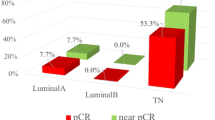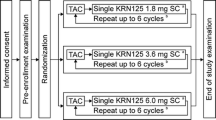Abstract
In an effort to improve the effectiveness of chemotherapy for breast cancer, examination of the impact of dose intensity, dose density, and treatment duration may have as much relevance as the specific antineoplastic agents utilized. After several years of pilot feasibility studies of dose-dense chemotherapy regimens, whose delivery has been made safe and feasible by the use of hematopoietic growth factor support (in particular, filgrastim), we now have phase III data demonstrating the advantages of this approach in the adjuvant treatment of breast cancer.






Similar content being viewed by others
References
Bonadonna G, Zambetti M, Valagussa P (1995) Sequential or alternating doxorubicin and CMF regimens in breast cancer with more than three positive nodes. JAMA 273:542–547
Citron ML, Berry DA, Cirrincione C, Hudis C, Winer EP, Gradishar WJ, Davidson NE, Martino S, Livingston R, Ingle JN, Perez EA, carpenter J, Hurd D, Holland JF, Smith BL, Sartor CI, Leung EH, Abrams J, Schilsky RL, Muss HB, Norton L (2003) Randomized trial of dose-dense versus conventionally scheduled and sequential versus concurrent combination chemotherapy as postoperative adjuvant treatment of node-positive primary breast cancer: first report of intergroup trial C9741/Cancer and Leukemia Group B Trial 9741. J Clin Oncol 21:1431–1439
Dang CT, Moynahan ME, Dickler MN, Seidman A, Fornier M, Theodoulou M, Lake D, Hurria A, Norton L, Hudis CA (2003) Phase II study of dose-dense (DD) 5-fluorouracil, epirubicin, and cyclophosphamide followed by alternating weekly paclitaxel (P) and docetaxel (D) in high-risk node-positive (N+) breast cancer: Feasibility and efficacy (abstract 46). Proc Am Soc Clin Oncol 22:12A
Fisher B, Bauer M, Wickerham OL, Redmond CK, Fisher ER, Cruz AB, Foster R, Gardner B, Lerner H, Margolese R (1983) Relation of positive axillary nodes to the prognosis of patients with primary breast cancer. Cancer 52:1551–1557
Fornier MN, Seidman AD, Theodoulou M, Moynahan ME, Currie V, Moasser M, Sklarin N, Gilewski T, D’Andrea G, Salvaggio R, Panageas KS, Norton L, Hudis C (2001) Doxorubicin followed by sequential paclitaxel and cyclophosphamide versus concurrent paclitaxel and cyclophosphamide: 5-year results of a phase II randomized trial of adjuvant dose-dense chemotherapy for women with node-positive primary breast cancer. Clin Cancer Res 7:3934–3941
Fornier MN, Seidman AD, Lake D, D’Andrea G, Bromberg J, Robson M, van Poznak CH, Panageas K, Norton L, Hudis C (2005) Increased dose-density is feasible: a pilot study of epirubicin and cyclophosphamide followed by paclitaxel at 10–11 day intervals with filgrastim support, for women with early breast carcinoma (abstract 616). Proc Am Soc Clin Oncol 23:16S
Green MC, Buzdar AU, Smith T, Ibrahim NK, Valero V, Rosales MF, Cristofanilli M, Booser DJ, Pusztai L, Rivera E, Theriault RL, Carter C, Frye D, Hunt KK, Symmans WF, Strom EA, Sahin AA, Sikov W, Hortobagyi GN (2005) Weekly paclitaxel improves pathologic complete remission in operable breast cancer when compared with paclitaxel once every 3 weeks. J Clin Oncol 23:5983–5992
Holland JF, Frei E, Bast RC, Kufe DW, Morton DL, Weichselbaum RR (eds) (2000) Cancer medicine, 5th edn. Williams and Wilkins, Baltimore
Hryniuk W, Levine MN (1986) Analysis of dose intensity for adjuvant chemotherapy trials in stage II breast cancer (abstract). J Clin Oncol 4:1162–1170
Hudis C, Fornier M, Riccio L, Lebwohl D, Crown J, Gilewski T, Surbone A, Currie V, Seidman A, Reichman B, Moynahan M, Raptis G, Sklarin N, Theodoulou M, Weiselberg L, Salvaggio R, Panageas KS, Yao TJ, Norton L (1999) 5-Year results of dose-intensive sequential adjuvant chemotherapy for women with high-risk node-positive breast cancer: a phase II study. J Clin Oncol 17:1118–1126
Hudis C, Seidman A, Baselga J, Raptis G, Lebwohl D, Gilewski T, Moynahan M, Sklarin N, Fennelly D, Crown JP, Surbone A, Uhlenhopp M, Riedel E, Yao TJ, Norton L (1999) Sequential dose-dense doxorubicin, paclitaxel, and cyclophosphamide for resectable high-risk breast cancer: feasibility and efficacy. J Clin Oncol 17:93–100
Jackisch C, Von Minckwitz G, Raab G, Schuette M, Blohmer JU, Hilfrich J, Gerber B, Costa S, Merkle E, Eidtmann H, Lampe D, DuBois A, Tulusan A, Caputo A, Kaufmann M (2002) Primary endpoint analysis of the Geparduo-study—preoperative chemotherapy (PCT) comparing dose-dense versus sequential adriamycin/docetaxel combination in operable breast cancer (abstract 152). Breast Cancer Res Treat 76:S50
Norton L (1988) A Gompertzian model of human breast cancer growth. Cancer Res 48:7067–7071
Norton L, Simon R (1986) The Norton–Simon hypothesis revisited. Cancer Treat Res 70:163–169
Saez RA, McGuire WL, Clark GM (1989) Prognostic factors in breast cancer. Semin Surg Oncol 5:102–110
Skipper HE (1986) Laboratory models: the historical perspective. Cancer Treat Rep 70:3–7
Therasse P, Mauriac L, Welnicka-Jaskiewicz M, Bruning P, Cufer T, Bonnefoi H, Tomiak E, Protchard KI, Hamilton A, Piccart MJ (2003) Final results of a randomized phase III trial comparing cyclophosphamide, epirubicin, and fluorouracil with dose-intensified epirubicin and cyclophosphamide plus filgrastim in locally advanced breast cancer. An EORTC-NCIC-SAKK multicenter study. J Clin Oncol 21:843–850
Trudeau ME (2001) Optimizing adjuvant breast cancer chemotherapy: rationale for MA.21 study. Oncology 15:7–13
Untch M, Konecny G, Ditsch N, Sorokina Y, Moebus V, Muck B, Kuhn W, Bastert G, Werner C, Thomssen D, Wallwiener U, Albert G, Bothman R, Kreignberg H, Lück J, Grosshadern K (2002) Dose-dense sequential epirubicin–paclitaxel as preoperative treatment of breast cancer: results of a randomized trial AGO study (abstract 133). Proc Am Soc Clin Oncol 21:34A
Wood W, Budman D, Korzun AH, Cooper MR, Younger J, Hart RD, Moore A, Ellerton JA, Norton L, Ferree CR (1994) Dose and dose intensity trial of adjuvant chemotherapy for stage II, node-positive breast carcinoma. N Engl J Med 330:1253–1259
Author information
Authors and Affiliations
Corresponding author
Additional information
This work was presented at the 20th Bristol-Myers Squibb Nagoya International Cancer Treatment Symposium, “New Concepts of Treatment Strategies for Hormone-Related Cancer”, 11–12 March 2005, Nagoya, Japan.
Rights and permissions
About this article
Cite this article
Seidman, A.D. Current status of dose-dense chemotherapy for breast cancer. Cancer Chemother Pharmacol 56 (Suppl 1), 78–83 (2005). https://doi.org/10.1007/s00280-005-0109-1
Published:
Issue Date:
DOI: https://doi.org/10.1007/s00280-005-0109-1




